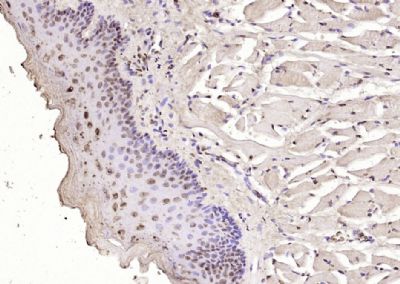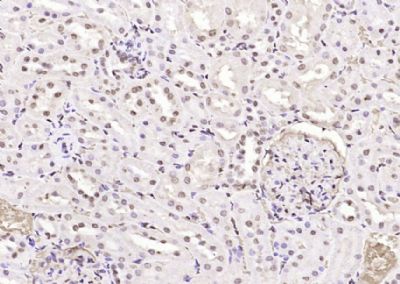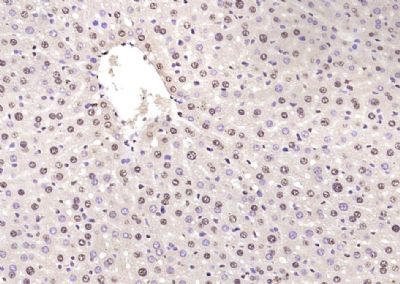FGGY Polyclonal Antibody
Purified Rabbit Polyclonal Antibody (Pab)
- 产品详情
- 实验流程
Application
| WB, IHC-P, IHC-F, IF, ICC, E |
|---|---|
| Primary Accession | Q96C11 |
| Reactivity | Rat, Dog, Bovine |
| Host | Rabbit |
| Clonality | Polyclonal |
| Calculated MW | 59993 Da |
| Physical State | Liquid |
| Immunogen | KLH conjugated synthetic peptide derived from human FGGY |
| Epitope Specificity | 151-250/551 |
| Isotype | IgG |
| Purity | affinity purified by Protein A |
| Buffer | 0.01M TBS (pH7.4) with 1% BSA, 0.02% Proclin300 and 50% Glycerol. |
| SIMILARITY | Belongs to the FGGY kinase family. |
| DISEASE | Defects in FGGY are associated with sporadic amyotrophic lateral sclerosis (ALS) [MIM:105400]. Amyotrophic lateral sclerosis is a neurodegenerative disorder affecting upper and lower motor neurons and resulting in fatal paralysis. Sensory abnormalities are absent. Death usually occurs within 2 to 5 years. The etiology of amyotrophic lateral sclerosis is likely to be multifactorial, involving both genetic and environmental factors. |
| Important Note | This product as supplied is intended for research use only, not for use in human, therapeutic or diagnostic applications. |
| Background Descriptions | FGGY is a 551 amino acid member of the FGGY kinase family that exists as four isoforms which are produced by alternative splicing events. Expressed in lung, kidney, small intestine, liver and fetal brain, FGGY is encoded by a gene that maps to chromosome 1 and, when mutated, is associated with sporadic amyotrophic lateral sclerosis (ALS). ALS is a neurodegenerative disorder that affects motor neurons and results in fatal paralysis, usually within 2 to 5 years after initial diagnosis. Chromosome 1, on which the gene encoding FGGY is located, is the largest human chromosome, spanning about 260 million base pairs and making up 8% of the human genome. There are about 3,000 genes on chromosome 1, many of which are associated with genetic diseases, including Hutchinson-Gilford progeria, familial adenomatous polyposis, Stickler syndrome, Gaucher disease and Usher syndrome. |
| Gene ID | 55277 |
|---|---|
| Other Names | FGGY carbohydrate kinase domain-containing protein, 2.7.1.-, FGGY |
| Target/Specificity | Expressed in fetal brain (at protein level). |
| Dilution | WB=1:500-2000,IHC-P=1:100-500,IHC-F=1:100-500,ICC=1:100-500,IF=1:100-500,ELISA=1:5000-10000 |
| Format | 0.01M TBS(pH7.4) with 1% BSA, 0.09% (W/V) sodium azide and 50% Glyce |
| Storage | Store at -20 °C for one year. Avoid repeated freeze/thaw cycles. When reconstituted in sterile pH 7.4 0.01M PBS or diluent of antibody the antibody is stable for at least two weeks at 2-4 °C. |
| Name | FGGY {ECO:0000303|PubMed:27909055} |
|---|---|
| Function | Catalyzes ATP-dependent phosphorylation of D-ribulose at C-5 to form D-ribulose 5-phosphate. Postulated to function in a metabolite repair mechanism by preventing toxic accumulation of free D-ribulose formed by non-specific phosphatase activities. Alternatively, may play a role in regulating D-ribulose 5-phosphate recycling in the pentose phosphate pathway. Can phosphorylate ribitol with low efficiency. |
| Tissue Location | Expressed in kidney, lung and small intestine and to a lower extent in liver and detected in cerebrospinal fluid (at protein level). |
Research Areas
For Research Use Only. Not For Use In Diagnostic Procedures.
Application Protocols
Provided below are standard protocols that you may find useful for product applications.
终于等到您。ABCEPTA(百远生物)抗体产品。
点击下方“我要评价 ”按钮提交您的反馈信息,您的反馈和评价是我们最宝贵的财富之一,
我们将在1-3个工作日内处理您的反馈信息。
如有疑问,联系:0512-88856768 tech-china@abcepta.com.
¥ 1,500.00
Cat# AP54596























 癌症的基本特征包括细胞增殖、血管生成、迁移、凋亡逃避机制和细胞永生等。找到癌症发生过程中这些通路的关键标记物和对应的抗体用于检测至关重要。
癌症的基本特征包括细胞增殖、血管生成、迁移、凋亡逃避机制和细胞永生等。找到癌症发生过程中这些通路的关键标记物和对应的抗体用于检测至关重要。 为您推荐一个泛素化位点预测神器——泛素化分析工具,可以为您的蛋白的泛素化位点作出预测和评分。
为您推荐一个泛素化位点预测神器——泛素化分析工具,可以为您的蛋白的泛素化位点作出预测和评分。 细胞自噬受体图形绘图工具为你的蛋白的细胞受体结合位点作出预测和评分,识别结合到自噬通路中的蛋白是非常重要的,便于让我们理解自噬在正常生理、病理过程中的作用,如发育、细胞分化、神经退化性疾病、压力条件下、感染和癌症。
细胞自噬受体图形绘图工具为你的蛋白的细胞受体结合位点作出预测和评分,识别结合到自噬通路中的蛋白是非常重要的,便于让我们理解自噬在正常生理、病理过程中的作用,如发育、细胞分化、神经退化性疾病、压力条件下、感染和癌症。








